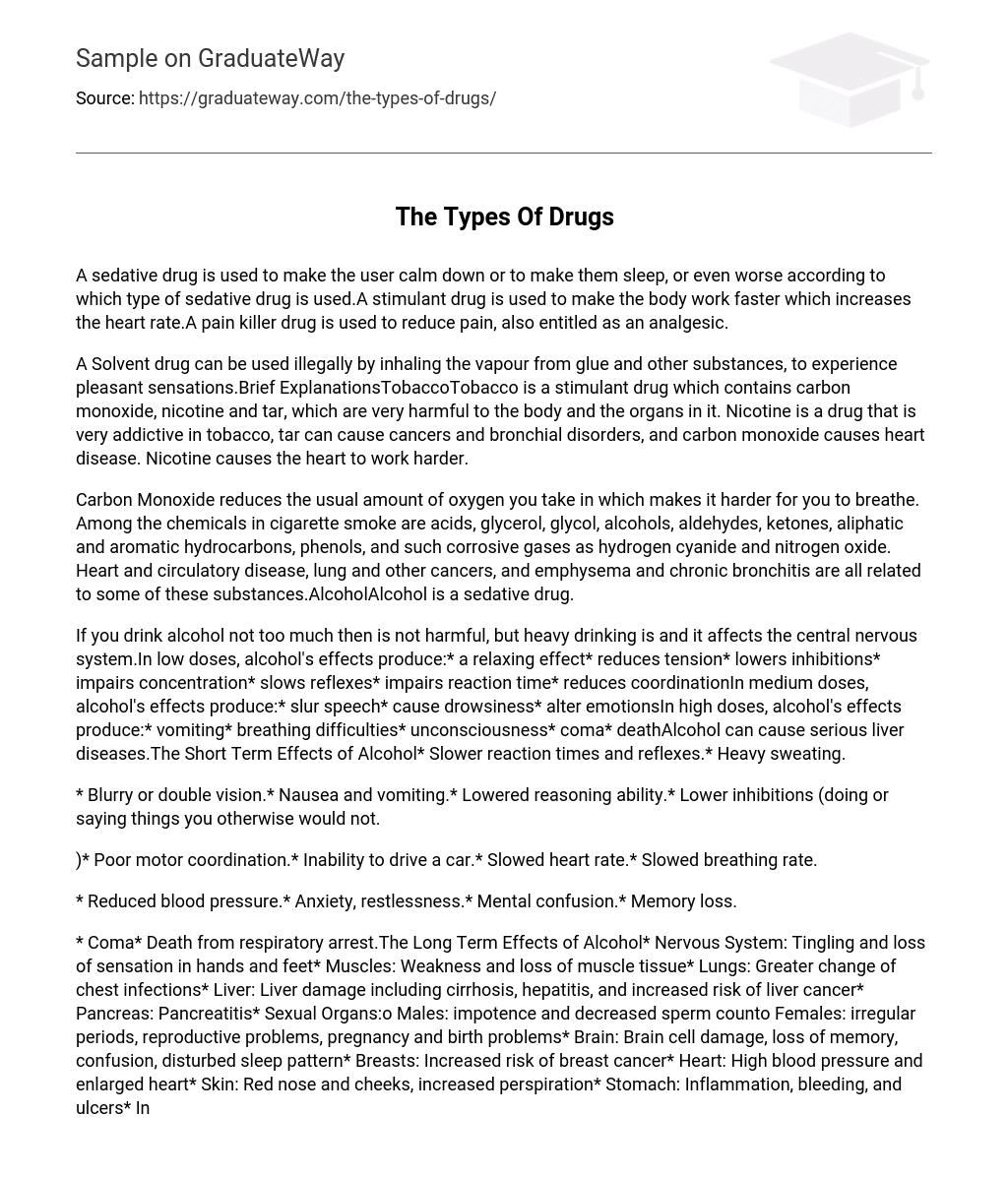A sedative drug is used to make the user calm down or to make them sleep, or even worse according to which type of sedative drug is used.A stimulant drug is used to make the body work faster which increases the heart rate.A pain killer drug is used to reduce pain, also entitled as an analgesic.
A Solvent drug can be used illegally by inhaling the vapour from glue and other substances, to experience pleasant sensations.Brief ExplanationsTobaccoTobacco is a stimulant drug which contains carbon monoxide, nicotine and tar, which are very harmful to the body and the organs in it. Nicotine is a drug that is very addictive in tobacco, tar can cause cancers and bronchial disorders, and carbon monoxide causes heart disease. Nicotine causes the heart to work harder.
Carbon Monoxide reduces the usual amount of oxygen you take in which makes it harder for you to breathe. Among the chemicals in cigarette smoke are acids, glycerol, glycol, alcohols, aldehydes, ketones, aliphatic and aromatic hydrocarbons, phenols, and such corrosive gases as hydrogen cyanide and nitrogen oxide. Heart and circulatory disease, lung and other cancers, and emphysema and chronic bronchitis are all related to some of these substances.AlcoholAlcohol is a sedative drug.
If you drink alcohol not too much then is not harmful, but heavy drinking is and it affects the central nervous system.In low doses, alcohol’s effects produce:
* a relaxing effect* reduces tension
* lowers inhibitions
* impairs concentration
* slows reflexes
* impairs reaction time
* reduces coordinationIn medium doses, alcohol’s effects produce:
* slur speech
* cause drowsiness
* alter emotionsIn high doses, alcohol’s effects produce:
* vomiting
* breathing difficulties
* unconsciousness
* coma
* deathAlcohol can cause serious liver diseases.
The Short Term Effects of Alcohol
* Slower reaction times and reflexes.
* Heavy sweating.
* Blurry or double vision.
* Nausea and vomiting.
* Lowered reasoning ability.
* Lower inhibitions (doing or saying things you otherwise would not.)
* Poor motor coordination.
* Inability to drive a car.
* Slowed heart rate.
* Slowed breathing rate.
* Reduced blood pressure.
* Anxiety, restlessness.
* Mental confusion.
* Memory loss.
* Coma
* Death from respiratory arrest.
The Long Term Effects of Alcohol Nervous System Tingling and loss of sensation in hands and feet Muscles Weakness and loss of muscle tissue Lungs Greater change of chest infections Liver Liver damage including cirrhosis, hepatitis, and increased risk of liver cancer Pancreas Pancreatitis Sexual Organs o Males impotence and decreased sperm counto Females irregular periods, reproductive problems, pregnancy and birth problems Brain Brain cell damage, loss of memory, confusion, disturbed sleep pattern Breasts Increased risk of breast cancer Heart High blood pressure and enlarged heart Skin Red nose and cheeks, increased perspiration.
Stomach:
Inflammation, bleeding, and ulcers.
Intestines:
Inflamed lining and ulcers.
Blood:
Changes in red blood cells.
Hands and Feet:
“Pins and Needles” and loss of sensationSolventsSolvents are legal and glue is a solvent, it is used to stick objects. Solvents are illegal only if they are inhaled into the human body.They act as a depressant and cause intoxication (being in a drunk state) and usually hallucinations.
They quickly make you have great happiness and they can cause overexcitement. They can also cause sudden death, brain damage, vomiting, and asphyxiation (the process of becoming unconscious without enough oxygen, and may die.CaffeineCaffeine is a stimulant drug it affects the central nervous system which makes you feel more energetic. It also increases the heart rate and breathing rate.
It increases the blood flow through your kidney which causes you to produce more urine. Large doses of caffeine (1,000 milligrams or more) can cause restlessness, sleeplessness, palpitations (when you feel your heart beating fast or irregular), and diarrhoea.A barbiturate is a sedative drug. It decreases the heart and breathing rate.
It can lead to sleep which can become a coma.Barbiturates slow down the central nervous system. Side effects of barbiturates include drowsiness. You will not be able to make decisions and usually will not be able to drive, mood changes may happen.
An overdose slows down the respiratory rate and may cause coma and death.Paracetamol is an analgesic, but overdose can cause it to become powerful which can lead to disastrous symptoms. The main uses of paracetamol are for relief of pain and for reducing a fever. In the first 24 hours after overdose you may experience a mild nausea and vomiting.
In a large overdose liver function gets weakened which leads to jaundice, confusion, and loss of consciousness. Death is rare but when it occurs it is due to liver failure.Heroin/morphine. A form of heroin is morphine; this drug is highly addictive.
It is a powerful analgesic (pain killer). Heroin is an opiate, it means a drug taken from opium. Heroin is made from the opium ingredient morphine. It takes away stress and discomfort.
They slow down the activity of the nervous system. They also cause widening of the blood vessels, which gives a feeling of warmth and slows down bowel activity (the lower part of the human body, it is where waste is passed on to the anus), which causes constipation (difficulty empting bowels).Solvents, Alcohol, Tobacco and Other DrugsA drug is a substance, which chemically alters body processes. Drugs depending on how they are used can be medically beneficial or if they are misused can cause great harm both physically and psychologically.
DrugDrug typeEffectsAlcoholSedativeSlower reaction times, blurred vision, slurred speech and loss of inhibitions (short term)Cirrhosis of the liver and brain damage (long term)TobaccoStimulantIncreased heart, breathing rate and energy (short term) Increased risk of circulatory disease, emphysema and lung cancer (long term)CaffeineStimulantIncreased heart, breathing rate and energy (short term)BarbituratesSedativeDecreased heart rate and breathing rate, leading to sleep, which can become a comaAmphetaminesStimulantIncreased heart rate and breathing rate, increased energy, which can become hyperactivityAspirinPain painkillerReduces painHeroinPain killerA form of heroin is morphine, this drug is highly addictive. It is a powerful analgesic (pain killer)





